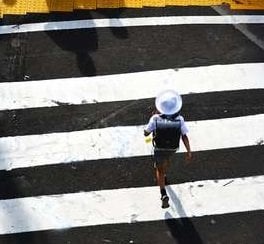Mum rallies locals to push for changes in her state: 'I think it would make a huge difference'
By
Danielle F.
- Replies 28
Have you driven through a school zone and felt your heart skip a beat as a child darted across the road?
For many drivers, the school run is a daily reminder of how vulnerable young Aussies are and why road safety rules matter more than ever.
Now, a major push is underway to make streets safer, and it could mean a significant change for drivers across the country.
Across Australia, calls for reduced speed limits in school zones grow louder.
A worrying rise in 'near-misses' has sparked this concern, along with the reality that even a slight speed boost could mean a tragedy.
In the Australian Capital Territory (ACT), a concerned mum recently had a terrifying experience.

Veronica witnessed a vehicle speeding past her as she crossed a school zone.
She was with her son, who was in a pram and was alongside her daughter.
Since then, she has advocated for change in their road rules.
'I think it would make a huge difference because it would make the area more welcoming to pedestrians,' Veronica shared in an interview.
'Speed bumps are not close enough to the crossing, and we may need more of them.'
'A wombat crossing [raised zebra crossing]… would really help because it would force cars to slow down right before they got to where children are,' she added.
Veronica's story was just one of the many cases related to school zones.
Parents, teachers, and road safety advocates across the country are demanding action.
One of these calls was for decreased school zone speed, from the initial 40 km/h down to 30 km/h.
Several local councils have since acted on it before their state or territory governments take action.
Melbourne's inner-city suburbs like Fitzroy and Collingwood have already reduced speed limits in school zones and high-foot-traffic areas.
Sydney hotspots such as Manly and Parramatta followed suit.
These changes resulted in safer streets, fewer accidents, and a more welcoming environment for pedestrians and cyclists.
Despite these rules implemented in Melbourne and Sydney, there's still a lot of work to be done.
Most places in NSW, Victoria, and South Australia still have a 40 km/h speed limit at school zones.
However, several parts of Queensland have a speed limit of 60 km/h.
A recent ACT-based study led by the Centre for Automotive Safety Research's Dr James Thompson found that many drivers were still speeding even with a 40 km/h limit.
Advocates have been pushing for a speed limit of 30 km/h in school zones.
According to experts, this speed lessens the risk of death if a pedestrian gets hit by a car.
'People continue to speed through zones, putting our most vulnerable at risk,' Peter Frazer OAM, a passionate road safety advocate, stated.
'If we could reduce speed-related fatalities by 40 per cent, that would mean about 550 fewer people being killed nationally each year.'
Frazer has been a road safety advocate after he lost his daughter to a distracted truck driver.
A Monash University Accident Research Centre study backed the proposed speed limit.
According to their findings, reducing speed limits to 30 km/h in high-pedestrian areas could halve the number of serious injury crashes.
However, It's not just about preventing accidents.
Lower speed limits make neighbourhoods more liveable.
Slower traffic encourages walking and cycling and could help to forge a more connected community.
For older Australians, who may feel less confident crossing busy roads, these changes could make a massive difference.
Despite the evidence, change can be slow.
Veronica and her fellow advocates in the ACT are still waiting for action, even after sharing their stories and near-misses.
However, momentum is building, with more councils and states slower speed limits in school zones and busy pedestrian areas.

Have you noticed drivers speeding through school zones? Will lowering the speed limit to 30 km/h make a difference? We would love to hear your thoughts and opinions about road safety in the comments below.
RELATED: 'Inexcusable': Police slam driver caught in shocking act on the road
For many drivers, the school run is a daily reminder of how vulnerable young Aussies are and why road safety rules matter more than ever.
Now, a major push is underway to make streets safer, and it could mean a significant change for drivers across the country.
Across Australia, calls for reduced speed limits in school zones grow louder.
A worrying rise in 'near-misses' has sparked this concern, along with the reality that even a slight speed boost could mean a tragedy.
In the Australian Capital Territory (ACT), a concerned mum recently had a terrifying experience.

School zones have a slower speed limit to keep children safe on the road. Image Credit: Pexels/Noe Garde
Veronica witnessed a vehicle speeding past her as she crossed a school zone.
She was with her son, who was in a pram and was alongside her daughter.
Since then, she has advocated for change in their road rules.
'I think it would make a huge difference because it would make the area more welcoming to pedestrians,' Veronica shared in an interview.
'Speed bumps are not close enough to the crossing, and we may need more of them.'
'A wombat crossing [raised zebra crossing]… would really help because it would force cars to slow down right before they got to where children are,' she added.
Veronica's story was just one of the many cases related to school zones.
Parents, teachers, and road safety advocates across the country are demanding action.
One of these calls was for decreased school zone speed, from the initial 40 km/h down to 30 km/h.
Several local councils have since acted on it before their state or territory governments take action.
Melbourne's inner-city suburbs like Fitzroy and Collingwood have already reduced speed limits in school zones and high-foot-traffic areas.
Sydney hotspots such as Manly and Parramatta followed suit.
These changes resulted in safer streets, fewer accidents, and a more welcoming environment for pedestrians and cyclists.
Despite these rules implemented in Melbourne and Sydney, there's still a lot of work to be done.
Most places in NSW, Victoria, and South Australia still have a 40 km/h speed limit at school zones.
However, several parts of Queensland have a speed limit of 60 km/h.
A recent ACT-based study led by the Centre for Automotive Safety Research's Dr James Thompson found that many drivers were still speeding even with a 40 km/h limit.
Advocates have been pushing for a speed limit of 30 km/h in school zones.
According to experts, this speed lessens the risk of death if a pedestrian gets hit by a car.
'People continue to speed through zones, putting our most vulnerable at risk,' Peter Frazer OAM, a passionate road safety advocate, stated.
'If we could reduce speed-related fatalities by 40 per cent, that would mean about 550 fewer people being killed nationally each year.'
Frazer has been a road safety advocate after he lost his daughter to a distracted truck driver.
A Monash University Accident Research Centre study backed the proposed speed limit.
According to their findings, reducing speed limits to 30 km/h in high-pedestrian areas could halve the number of serious injury crashes.
However, It's not just about preventing accidents.
Lower speed limits make neighbourhoods more liveable.
Slower traffic encourages walking and cycling and could help to forge a more connected community.
For older Australians, who may feel less confident crossing busy roads, these changes could make a massive difference.
Despite the evidence, change can be slow.
Veronica and her fellow advocates in the ACT are still waiting for action, even after sharing their stories and near-misses.
However, momentum is building, with more councils and states slower speed limits in school zones and busy pedestrian areas.
Key Takeaways
- There has been a growing push in the ACT and other parts of Australia to lower school zone speed limits from 40 km/h to 30 km/h.
- Road safety experts and advocates argued that reduced speed limits in school zones and high pedestrian areas significantly decrease the risk and severity of crashes.
- Studies, such as those from the Centre for Automotive Safety Research and Monash University, support the move, indicating that dropping speed limits could reduce serious injury crashes by up to 50 per cent.
- Some local councils around Australia have already implemented lower speed limits in busy pedestrian areas, and there are calls for other jurisdictions to adopt similar changes.
RELATED: 'Inexcusable': Police slam driver caught in shocking act on the road







